We’ve talked about how to write effective subject lines and preheaders.
But what about the actual content of your emails?
This is where the rubber meets the road. You’ve got to fulfill subscriber expectations, be consistent with the subject line and preheader, strengthen their trust in your brand (so that they open future emails), delight them, and drive them toward taking the action you want them to take.
Easier said than done, of course.
And that’s why writer’s block is such a consistent problem for many email marketers… how can you write effective email copy without overthinking it?
More importantly, how do you know it’s going to be effective before you send it?
That’s what we’re going to teach you in this article!
And we’re going to break it down by business-type (because different types of businesses require different types of emails).
Click the link below to learn how to write emails for your specific business model!
1. How to write emails for eCommerce
2. How to write emails for SaaS
3. How to write emails as a Thought Leader
Note: We will not be discussing basic receipt emails, feedback requests, or other basic emails within this article. The purpose of this guide is to help you with the creative, sales-based, relationship-building part of email copywriting. So that’s what we’re going to focus on.
What Is Email Copy & Why Is it Different?
Email copy is the actual content — the design elements, words, and how they flow together — that are inside an email campaign, only viewable after someone opens.
This is arguably the most important part of your emails.
Assuming that your deliverability is adequate, and that your subject lines and preheaders are generating decent open rates, it all comes down to the content of your email.
Is your email persuasive?
Is it entertaining?
Does it build trust and strengthen your relationship with your subscribers?
Does it fulfill subscriber expectations?
Does it drive people toward taking the action that you want them to take (buying a product, registering for an event, reading a blog post, etc)?
Those are questions you should ask yourself every time that you draft an email — and those are the questions we’re going to help you answer in this article.
It’s also important to keep in mind that an email copy is fundamentally different than the copy of a landing page or website.
Here are a few key distinctions…
Emails are Much Shorter (Usually)
According to research by Boomerang where they analyzed the response rate of 5.3 million emails, the ideal length for an email is between 50 and 125 words.
And while response rate isn’t the only mission-critical metric you’re probably worried about, shorter emails will (usually) outperform long emails wherever it counts.
Email is a Bridge, Not a Sales Page
To be clear, even a sales email is not the same as a landing page — in fact, it doesn’t even have the same goal.
In the same way that a headline’s only goal is to get people to read the first sentence, an email’s only goal is to get people to click-through to the next page (whether that’s a blog post or a sales page or a podcast episode).
Email is not the place to respond to long lists of objections, tell thousand-word stories, or describe all the details of your product.
It’s simply a bridge that takes people toward step number 2. Strengthen the relationship, create curiosity, drive clicks… but let your sales pages do the rest.
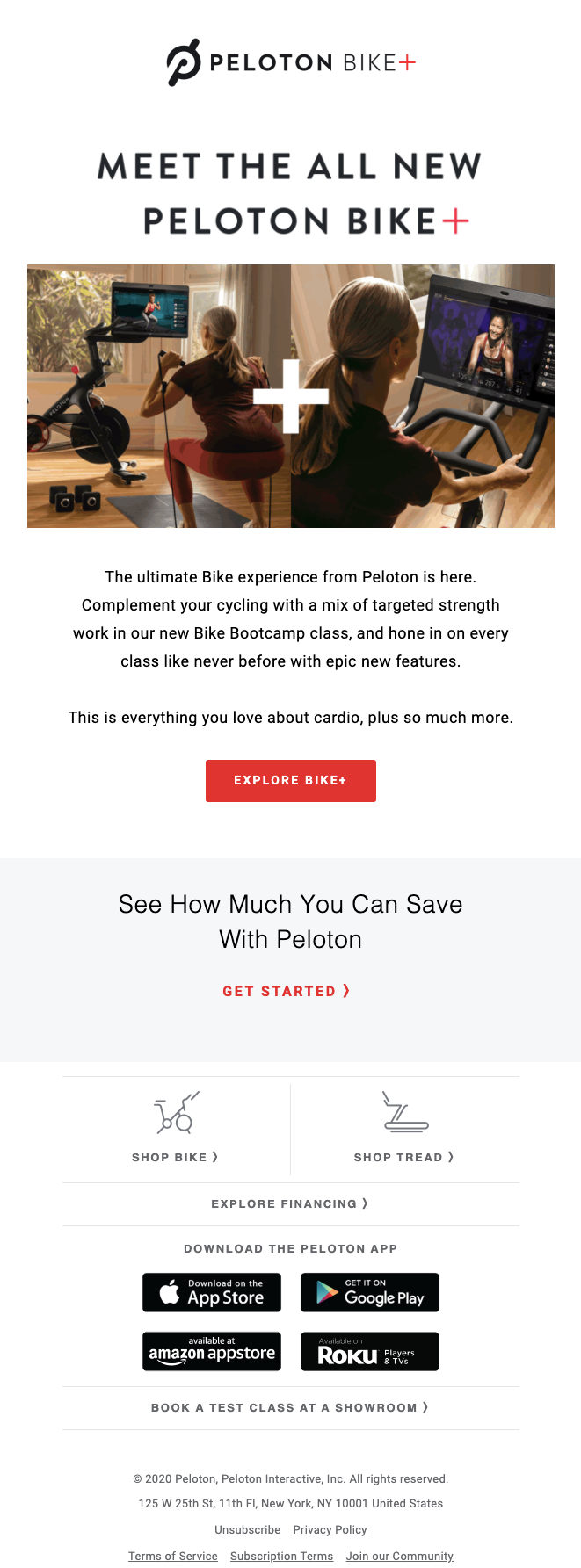
Email Copy Includes All Content
Most of the time when marketers talk about copy, they’re talking about the actual words that persuade, convince, or work to sell a product. But when we say “email copy”, we’re talking about all of the elements within that email — the design, the images and videos, the gifs, and the words.
In an email, all of those things come together to create a unique experience and, if done well, one that will guide the recipient seamlessly toward the action that you want them to take.
Email is For Warm Traffic (Usually)
Don’t forget: if you’ve been emailing your audience for months or years… then they already know who you are and many of them probably trust you (which is why they’re still on your list).
Your emails, then — with the exception of your welcome sequence — should speak to warm traffic.
That is, you don’t need to introduce yourself or overcompensate with trust-badges and testimonials. Many of these people know you and trust you already; embracing that in your email copy (and writing like you’re speaking to friends) is a great technique for improving engagement.
So now the question is, how do you consistently write effective emails for your business?
Also, what types of emails should you send and when should you send them? What’s the ideal emailing cadence?
That’s what we’re going to talk about next.
Let’s break it down by business-type.
How To Write Effective Email Copy For eCommerce
There are 4 fundamental parts to an effective email marketing strategy for your eCommerce brand. Here’s what they are:
- The Welcome Email
- The Sales Email
- The Abandoned Cart Email
- The Post-Purchase Email
Here, we’re going to break down how you should craft each of those emails and when you should send them.
The eCommerce Welcome Email
The goal of the eCommerce welcome email is to introduce your brand, share your mission, build trust, and recommend a popular product.
(The welcome email is also a good time to ask subscribers to customize their email preferences).
Here’s an example from Bite (this is their first welcome email)…

Here’s another example from Riley…

You’ll notice that these emails are pretty heavy on design elements. That’s typical for eCommerce emails.
It’s okay to let the design do some of the heavy-lifting — just make sure that the images you include help paint a picture of what your subscribers are striving for.
We recommend sending this initial welcome email immediately after someone signs up.
For eCommerce, the CTA of this email is typically to purchase a popular product.
(And while we don’t usually recommend selling in the welcome email, if done correctly, it’s not such a bad idea for eCommerce)
Here’s a script you can use. It has all of the basic elements you need in an eCommerce welcome email, but feel free to tweak it so that it matches your brand.
Welcome to the [BRAND NAME] tribe!
We’re excited to have you.
Our mission here is to [MISSION STATEMENT].
And we accomplish that mission by [MOST POPULAR PRODUCT].
[TESTIMONIAL]
Want to see for yourself? Go check it out!
[CTA]
P.S. We send about [NUMBER] emails per week. But you can adjust your email preferences over here!
Here’s an example…
Welcome to the Email Mastery tribe!
We’re excited to have you.
Our mission here is to help entrepreneurs and marketers build better relationships with their subscribers so that they can grow their businesses.
And we accomplish that mission with our new Email Marketing Gizmo 5000. It increases the open rate, click-through rate, and response rate of email campaigns… every single time.
“My business started growing three times as fast when I implemented the Email Marketing Gizmo 5000!” — Honest Henry
Want to see for yourself? Go check it out!
[Shop The Email Marketing Gizmo 5000!]
P.S. We send about 3 emails per week. But you can adjust your email preferences over here!
The eCommerce Sales Email
Sometimes, you’re just going to want to try and boost sales with an email.
Maybe this is because of a new product launch, maybe you’re running a special offer, or maybe you’re just trying to remind people of a cool product you created.
It’s generally a good idea to have a reason for emailing people about a product — if there’s not a reason, create one!
(Consider creating a marketing calendar that follows the holidays — Halloween, Thanksgiving, Christmas, Black Friday, Cyber Monday, Valentines Day, 4th of July, etc. That’ll help you get promotional content ideas for each season)
Whatever the reason, sales emails are absolutely critical for maintaining eCommerce revenue. And we recommend sending them once or twice per week.
Here’s an example of what this looks like…
You have a few different options when you’re sending a sales email like this.
You can feature a specific product, you can feature a special sale or time-sensitive deal, or you can feature multiple products.
We recommend doing a little of all three.
And while every sales email is going to be a bit different based on the product or offer that you’re featuring, here’s a general format you can use…
- Introduce The Product — Who is the product for? What problem does it solve or what benefit does it offer? Most importantly, how will people feel after they purchase?
- Share a Few Features — What are the cool features that the product has? What makes it unique?
- Add Social Proof — Prove that the product works or is at least high-quality. You can do this by sharing testimonials or reviews.
- Create Urgency/Scarcity (Optional) — Is the sale going to end soon? Or maybe you only have so many products in stock? Share that with your subscribers!
Here’s an example of an eCommerce sales email from Allbirds.
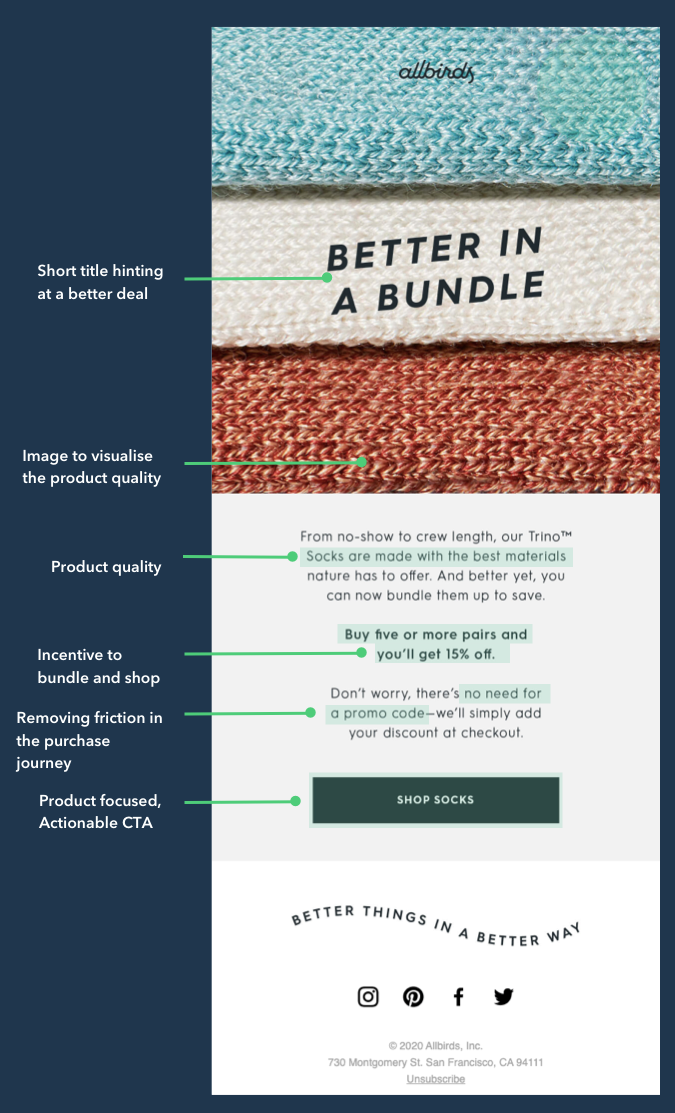
If you want to feature a special deal rather than a specific product, then just flip the 1st and 4th steps and change “Product” to “Products” — basically, you just want to finish by giving people an idea of the products that they can purchase with their special discount.
Here’s an example…
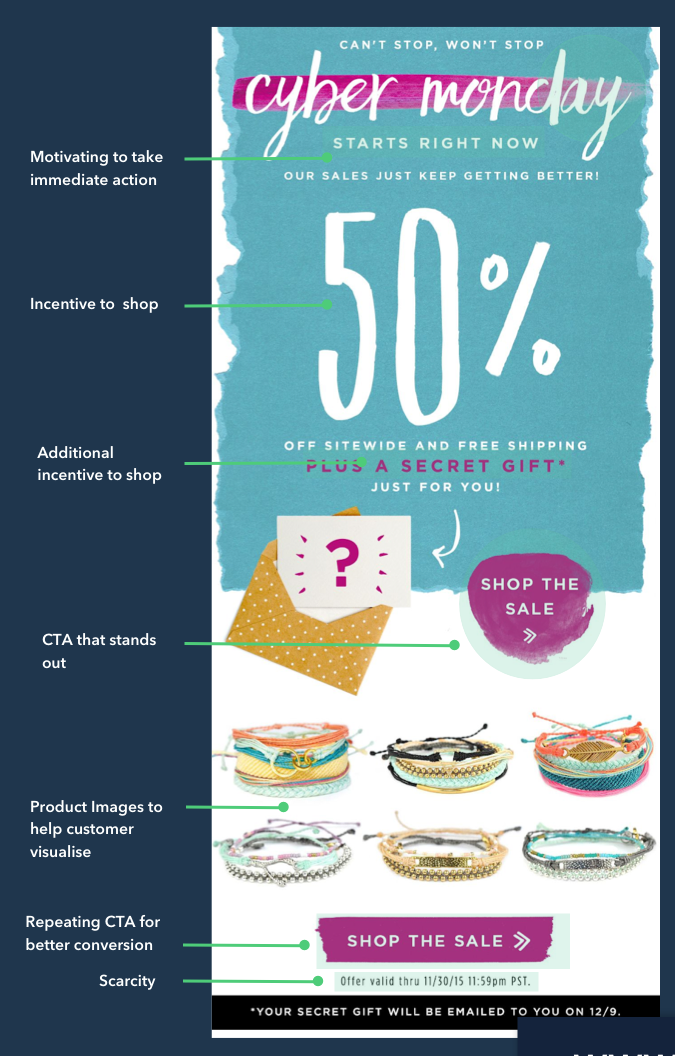
The copy doesn’t need to be super complicated here.
Just share the cool features of your product, show people how they can use it, and maybe create a little urgency or scarcity.
In eCommerce, it’s a good idea to let images do most of the selling — people want to imagine wearing, using, or owning your products, and visuals are a great way to help them visualize.
The eCommerce Abandoned Cart Email
In the same way that you need a welcome email and sales emails for your eCommerce business, you also need an abandoned cart email.
It really is that important.
Because while 69% of online shopping carts get abandoned, 40% of cart abandonment emails are opened, 21% are clicked, and, of the people who clicked, 50% end up purchasing.
If you don’t have a cart abandonment email, then you’re leaving money on the table — plain and simple.
Here’s an example of a cart abandonment email…
The cart abandonment email also doesn’t need to be complicated.
Just remind people of the product or products that are in their cart, add a little bit of incentive for them to finish their purchase, and add a CTA.
Here’s another version that’s a little bit different…

And here’s a basic script you can use to craft your abandoned cart email…
Did you leave your [PRODUCT NAME] in your cart?
Go claim your [PRODUCT NAME] before it’s gone!
[CTA]
[TESTIMONIAL/STAR-RATING]
And here’s a quick reminder of what [PRODUCT NAME] can do for you.
[SHORT LIST OF COOLEST FEATURES]
Here’s an example…
Did you leave your Email Mastery Gizmo 5000 in your cart?
Go claim your Email Mastery Gizmo 5000 before it’s gone!
[Go To My Shopping Cart]
The Email Mastery Gizmo 5000 has 5-star reviews on Google and Facebook!
And here’s a quick reminder of what the Email Mastery Gizmo 5000 can do for you.
- More Engagement — [detailed description]
- More Conversions — [detailed description]
- More Consistent Business Revenue — [detailed description]
[Go To My Shopping Cart]
The eCommerce Post-Purchase Email
Maybe you don’t think of the post-purchase email as all that important.
After all, the person already purchased… which was your primary goal. Why does it matter so much what you say in the email after they purchase?
Well, the answer is pretty simple: return customers are easier to sell to than new customers.
If you don’t make the most of the entire buying experience (post- as well as pre-), then you’re not just leaving money on the table… you’re leaving the relationship on the table, which means that they might not buy from you again in the future
Believe it or not, post-purchase emails are your best chance to forge a long-term relationship with your new customer.
Here’s an awesome example of what this can look like from Bellroy…

And here’s another simpler example from Crate&Barrel…
Your post-purchase emails (just like other eCommerce emails) don’t need to be complicated… but they do need to be well-crafted.
Here are some different types of post-purchase emails that you might consider sending to build stronger relationships with your subscribers (beyond basic transactional emails).
Delivery Check-In — Nothing says “We actually care about you” quite like checking to make sure that the product arrived on time.
Send an email on the day that it’s supposed to be delivered and celebrate with them, ask them what they think, or even just give them your phone number so they can call if there are any problems.
Feedback Request — Requesting timely feedback on your products serves two important purposes. First, it gives you valuable information about the products that you’re selling. And second, it shows your new customers that you care what they think. This is extremely useful for building a meaningful relationship with your subscribers.
Product Recommendations — When someone buys, that tells you a lot about the type of products that they’re probably interested in. Why not create some segments and send emails to new customers (after a few weeks of enjoying their original product) with product recommendations?

Additional Gift — You just acquired a new customer. Why not thank them by offering them a little discount on their next purchase? Research shows that the more people buy from you now… the more they’re going to buy from you later.
“How-To” Content — The more that people use your product and the more that they enjoy using it, the better chance there is that they’re going to return for more.
But how do you ensure that every customer has a great experience with your product? By showing them how to use it! Here’s a great example from Beardbrand.

As for your first post-purchase email with order details, it should send immediately after someone checks out (tracking information might need to send a little bit later). You might also consider sending shipping updates and asking for a product review down the road.
Here’s a simple script you can use for your first post-purchase email…
Thank you for your order!
We’re packing it up right now and we’ll send you the tracking information once it’s on the way (should just be a couple days).
Here’s your order information
[ORDER DETAILS]
If you need anything, give us a call at [PHONE NUMBER] — we’re happy to help.
And in the meantime, maybe you’ll be interested in some of these other products. Our other customers absolutely love ‘em!
[RECOMMENDED PRODUCTS]
P.S. We’re excited to have you as a customer! In fact, use code [DISCOUNT CODE] at checkout to get 10% off your next order. 🙂
How To Write Effective Email Copy For SaaS
There are 3 fundamental parts to an effective email marketing strategy for your SaaS brand. Here’s what they are:
- The Onboarding Sequence
- The Customer Retention Email
- The Upgrade Email.
Here, we’re going to break down how you should craft each of those emails and when you should send them.
The SaaS Onboarding Sequence
Typically with SaaS companies, a free trial or freemium plan is the primary lead magnet — which means that practically every subscriber has some degree of access to the service.
What’s a ‘welcome email (or series)’ in other industries, then, becomes an onboarding sequence in SaaS. This onboarding sequence usually includes feature introductions, encouragement to build a habit around the service, and periodic upsells.
In Grammarly’s case (check out our full Grammarly Teardown over here), for example, the only way to join their email list is by signing up for the free version of their service (a great lead magnet idea, by the way).
Here’s what Grammarly’s first onboarding email looks like…

You’ll notice that this email follows a pretty basic format.
- Introduce the service and why it’s important.
- Writing opens a line of communication between you and other people. And when you commit to improving your writing, you open yourself up to better conversations, remarkable accomplishments, and healthier relationships. Grammarly will help you succeed.
- Introduce HOW to use the service…
- Grammarly offers clear, effective, mistake-free writing across multiple devices, browsers, and apps. You’ve already decided on the browser extension. So, here’s a list of other free products you can install to access Grammarly where you write.
- Feature Introductions: Easy Editing, Custom Settings, Handy Shortcuts
- Encourage subscribers to customize email preferences…
- We care about earning and keeping your trust, so we wanted to let you know that you’re signed up to receive the following emails from Grammarly… You can update your email preference settings at any time (we will include this link at the bottom of every email we send you).
- Brief upsell CTA…
- Grammarly Premium includes pro features like vocabulary enhancement, consciousness suggestions, and plagiarism checks. [LEARN MORE].
You can use a similar format for your first email when someone signs up for your free trial.
One day later, Grammarly sends out this email, which is awesome for encouraging new users to actually try out the service.

Here’s something that every SaaS marketer needs to understand: the more that customers build a habit around your service, the longer they’re going to stick around.
So it’s a good idea to send an email like this, which encourages users to download your service on multiple platforms so that they can use it whenever and wherever they want.
For your business, this might mean sending an email that encourages the subscriber to download a mobile app or make use of one of your key features.
All in all, here are the emails that we recommend including within your SaaS onboarding sequence.
Welcome Email — Thank new subscribers for signing up and provide everything they need to start using your service. That includes links to resources and downloads, how-to articles, and examples of how other people like to use your service.

Key Feature Introductions — Introduce your subscribers to some of your exciting and popular features. This doesn’t need to be just one email, either. You could send 3-5 emails, where each one introduces a new feature.
Upgrade Email — Finally, after the subscriber has had some time to try out the free version of your product, send an email that upsells them to the paid version. This email should discuss the benefits of upgrading and it might also include a temporary discount and some social proof from other members (like testimonials or reviews).
The SaaS Customer Retention Emails
Customer retention is perhaps the single most important metric for SaaS businesses.
Because SaaS relies on monthly or yearly subscriptions — and because it’s more costly to sell to a new customer than it is to retain an existing customer — high retention and low churn is critical for success.
Email marketing can help with that.
How?
By periodically sending emails that encourage usage, promote product-centered habit creation, remind customers why your service is critical to their lives, or announce features that inspire re-engagement.
More specifically, these are the emails we recommend sending as a part of your customer retention strategy. Try sending these weekly or bi-weekly.
Note: Segmentation is very important for customer retention. That way, you can send re-engagement emails to people who haven’t used your service in a while, and encourage continued usership among those that are consistently logging in. Check out our full guide to email segmentation over here.
Re-Engagement Campaign — People who haven’t engaged with your service for a few months are more likely to cancel their subscription. That’s why it’s important to send re-engagement emails.
These campaigns might remind people of why your service is important or how, if used consistently, it can make a positive impact on their lives.
Build-a-Habit Emails — Get your subscribers to build a habit around your product, make it something that they do every day or every week, and they’re probably not going to cancel.
That’s why sending emails that encourage product-centric habit creation is a good idea. These might come in the form of weekly progress updates or customized usage reports.

Feature Announcements/Reminders — Reminding users of service features or announcing new features is another great way to keep subscribers engaged.
Obviously, promote brand new features whenever they launch, but also get in the habit of periodically reminding people of features that they may have forgotten about.
The SaaS Upgrade Emails
Consistently upgrading people from your freemium plan to one of your paid plans is an important part of the SaaS business model.
Naturally, email is one of the best ways to drive those upgrades.
You can do this by discussing the benefits of upgrading as well as the cons of staying on the free plan, share testimonials of people who are using the upgraded versions, and maybe even provide a temporary discount for those who take the leap.
Here’s a simple example from Evernote…
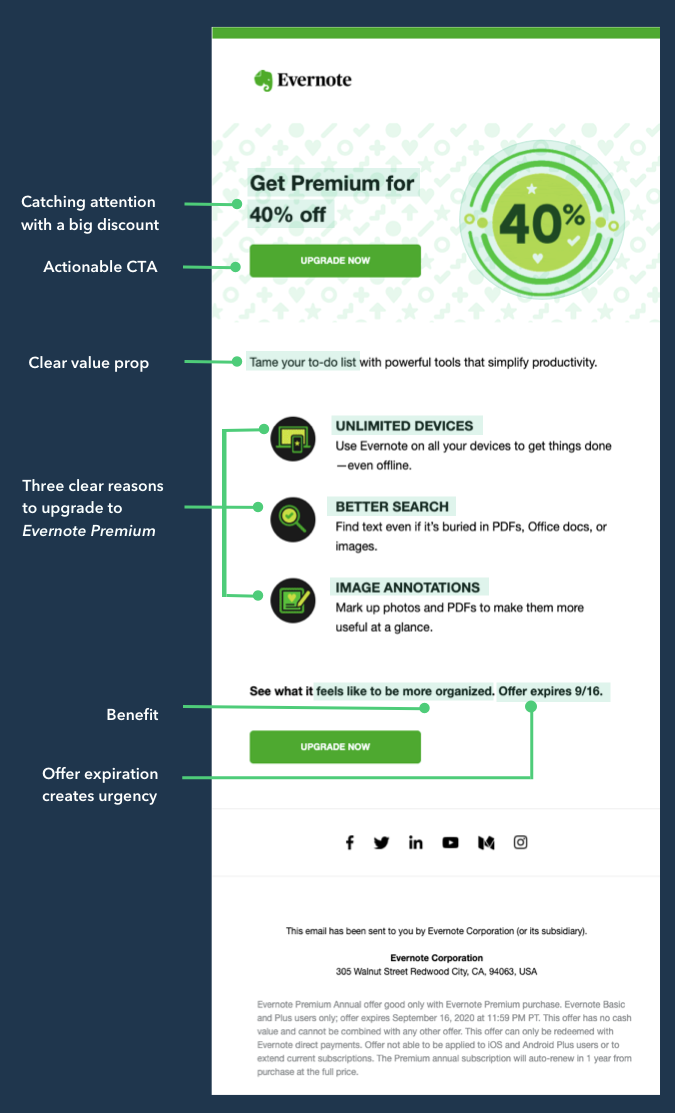
But there are a lot of different ways to create these upgrade emails. And we recommend sending different upgrade emails with different incentives and feature-mentions weekly or bi-weekly.
Two of the most effective upgrade emails are discount campaigns…
And benefit/feature spotlights…

To make these emails effective, we recommend including the following elements when it’s appropriate.
- Urgency/Scarcity — Whenever you’re running a promotion, make sure that people know it’s not going to last forever. Set a hard end date and send emails that notify people that it’s their last chance to sign up. The vast majority of upgrades will come during the final moments of your promotion.
- FOMO — FOMO (Fear Of Missing Out) is a powerful emotion in humans. Basically, we don’t like missing out on things that could benefit us. So mention features and applications that freemium users are missing out on by not upgrading their plan.
- Benefits & Cons — Sharing the benefits of upgrading as well as the cons of remaining on the free plan is a great way to gently push people toward your paid plans. Don’t overdo it, of course, but also don’t be afraid to discuss the features and plans that will be the most beneficial to your subscribers.
Be careful of over-utilizing these tactics or you risk annoying and frustrating subscribers. Used sparingly, however, these emails can make a massive difference in your ratio of freemium users to paying customers.
How To Write Effective Email Copy For Thought Leader Businesses
There are just 2 fundamental parts to an effective email marketing strategy for your thought leader business. Here’s what they are:
- The Welcome Sequence
- The Daily or Weekly Emails.
We’re going to break down how you should craft each of those campaigns and when you should send them.
To be clear, thought leader businesses are individuals or companies that sell coaching and consulting services or information products (like courses and books).
The Thought Leader Welcome Sequence
The welcome sequence is the first set of emails you should send when you get a new subscriber. These should trigger automatically inside of your email service provider.
But what exactly should your welcome sequence consist of?
The Thought Leader Welcome Sequence (Email 1)
Well, the first email — your welcome email — will likely be the delivery of your “bribe to subscribe,” assuming that the person signed up via one of your lead magnets.
In the case of Smartblogger — a website owned by Jon Morrow that’s one of the top authorities for bloggers — that’s exactly what happens: they deliver their bribe to subscribe, Headline Hacks.
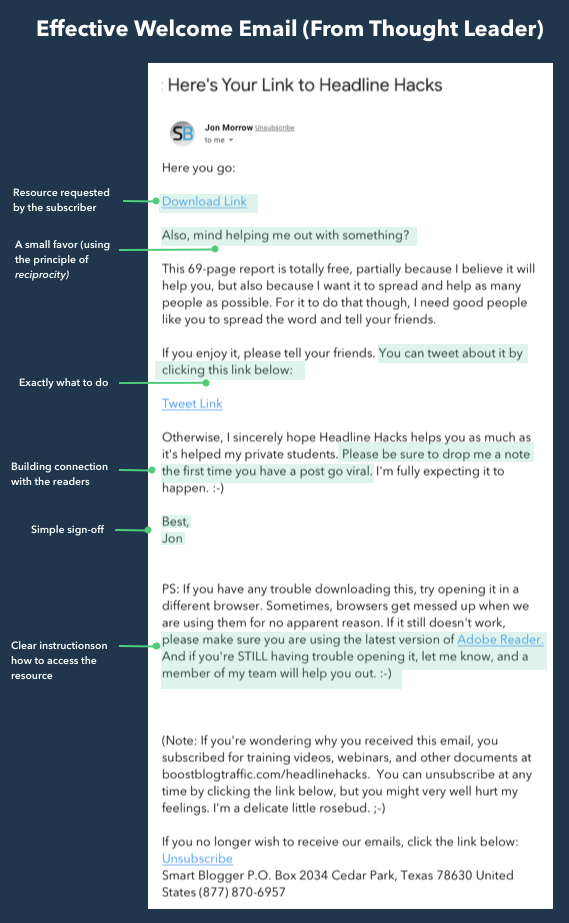
This is a great structure for a bribe delivery email.
Give the person the resource they asked for and ask them to share it. This first email really doesn’t need to be too complicated.
You’ll also notice that Smartblogger’s emails don’t have nearly as much design work as the other emails we’ve looked at — that’s an important distinction for thought leader emails.
Typically, thought leaders brands are more connected to a person than they are to a logo or set of colors. For that reason, it’s often a good idea for thought leaders to craft their emails, design-wise, as if they’re speaking to a friend or colleague.
From here, we think the best thing to do — and what most online marketers recommend — is to create a 3-5 part email sequence that aims to sell your core offer to the new subscriber.
And that’s exactly what Jon Morrow does.
The Thought Leader Welcome Sequence (Email 2)
Here’s the email we received next (one day later after the Headline Hacks delivery).

The genius behind this second email in Smartblogger’s welcome sequence is that it focuses on exactly what Jon’s target market wants most… becoming noteworthy writers.
(Also notice how well the subject line flows into the preheader)
Here’s the basic flow of this first email broken down into pieces…
- Build Authority (Without Bragging) — To be a thought leader, you need to be a thought leader. That is, you need to build authority with your target market and prove to them that you really do know what you’re doing. This is something that should happen early on in your welcome sequence. The best way to do this is to share the real-life results of your systems and processes. Don’t brag about it and talk about how awesome you are, though… just let the results do the talking.
A few years ago, Forbes approached me about writing a column for them. I was already booked solid, so I politely turned them down, but I still couldn’t help feeling flattered that they offered.
Earlier in my career, I would’ve killed for a gig like that. I also would’ve been shocked to find out exactly what it takes to get offered one.
For instance, you would think it’s about being a great writer, right? Or having impeccable credentials?
But it’s not.
- Explain How You Can Help — Then make it abundantly clear how you can help. What is it you’re an expert at and what is the one thing that you can help the recipient accomplish? In Jon Morrow’s case, this is helping bloggers make money with their writing.
Let’s say you’re a beginning writer. You have talent, you’re willing to work hard, and you genuinely respect the craft.
How can YOU write an article that goes viral, turning you into a writer everyone wants to publish?
Nobody tells you. Like it’s some big secret or something.
But that’s silly. If more talented writers knew how to get the traffic they deserve, the whole world would be better off.
- Build Suspense — Since this is just the second email of your welcome sequence, make sure you build suspense for the remaining emails. After all, you want people coming back tomorrow and the next day. Jon does this with the following copy…
I’m releasing a case study of how I wrote and promoted the article that got over 1 million visitors. I’ll send it to you in pieces over the next few days.
It won’t cost you a dime, either. I could easily charge for it, but I’ve decided to release the entire case study for free.
Not because I’m selfless. I’m just a believer in karma, and if I help you out, I figure it’ll come back around to me sooner or later.
Watch your inbox. You’ll get an email tomorrow with the subject line “How to Become a Highly Sought-After Writer (Part 1).”
It’s going to be a lot of fun. Hope you’re excited.
Talk soon,
Jon
The Thought Leader Welcome Sequence (Email 3)
Jon’s third email piggybacks on his second email.
Here it is.
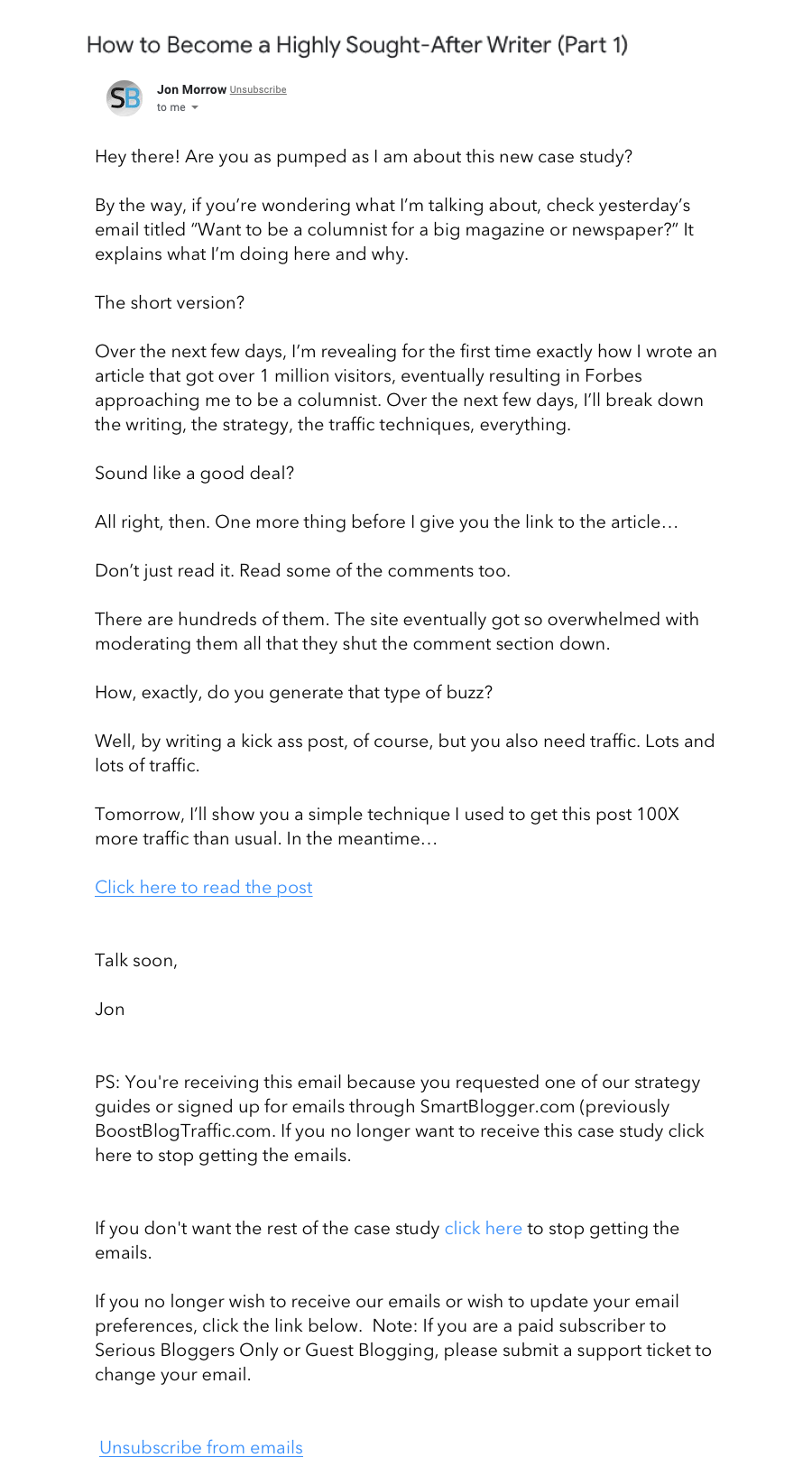
The first half of this email is dedicated to simply reminding the subscriber about what he’s going to share over the next few days.
Then he builds a little more authority by sharing how he got a ton of comments on his article, he builds suspense for tomorrow’s email by saying, “Tomorrow, I’ll show you a simple technique I used to get this post 100x more traffic than usual.”
And then he delivers the goods that he promised in the previous email — in this case, the link takes them to an article Jon wrote, titled, “How to Quit Your Job, Move to Paradise and Get Paid to Change the World.”
Notice how each email delivers the thing that was promised yesterday and builds anticipation for tomorrow’s email? This is often referred to as a “Soap Opera Sequence” in the online marketing world.
In a Soap Opera Sequence, each email closes the loop opened from the previous email and then builds anticipation for the next — that keeps people coming back for each email.
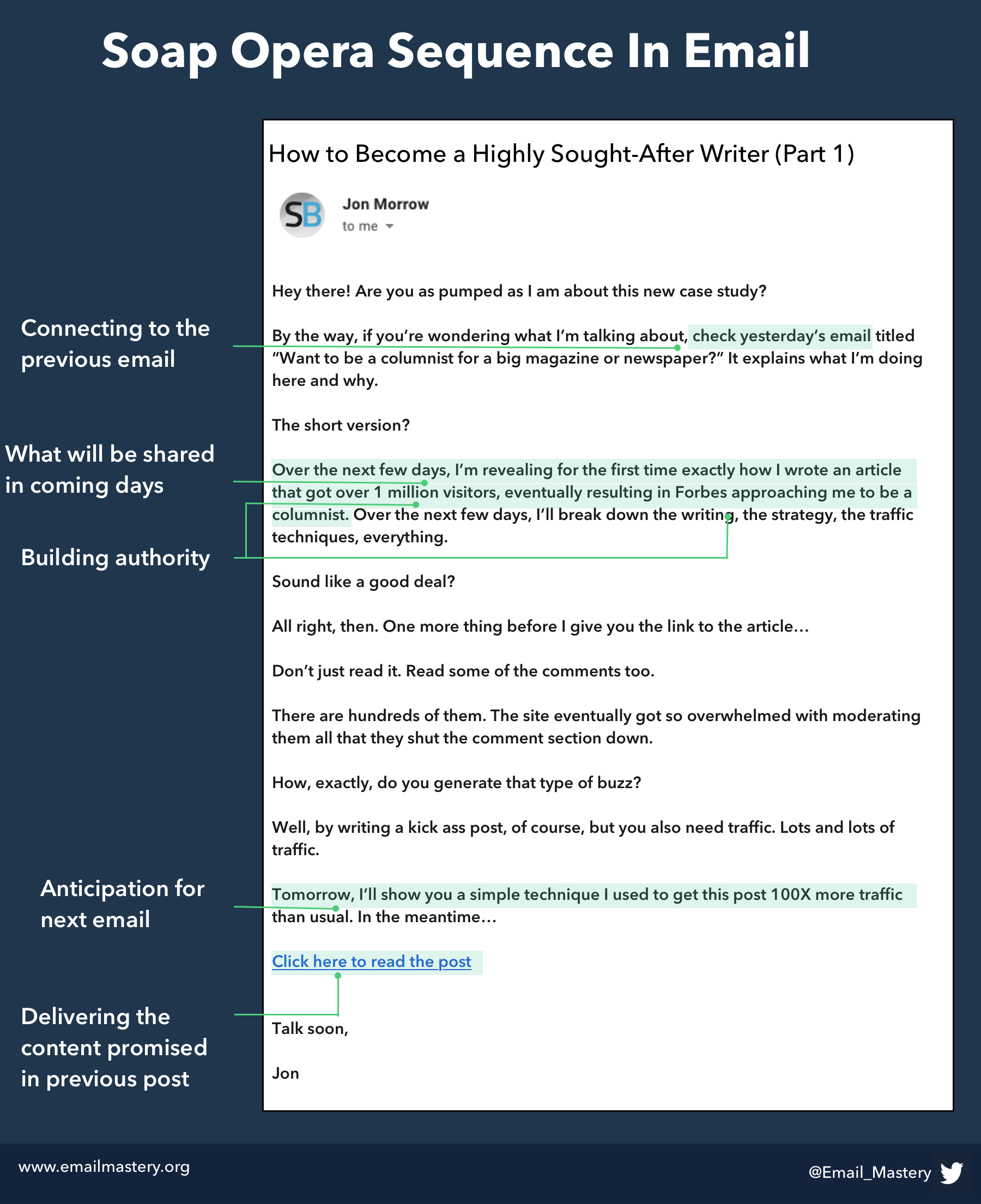
And by email number five, the idea is that you will have built enough trust and authority that the prospect will finally be ready to buy.
Now let’s take a look at email #4.
The Thought Leader Welcome Sequence (Email 4 & 5)
Here’s the email we received next…
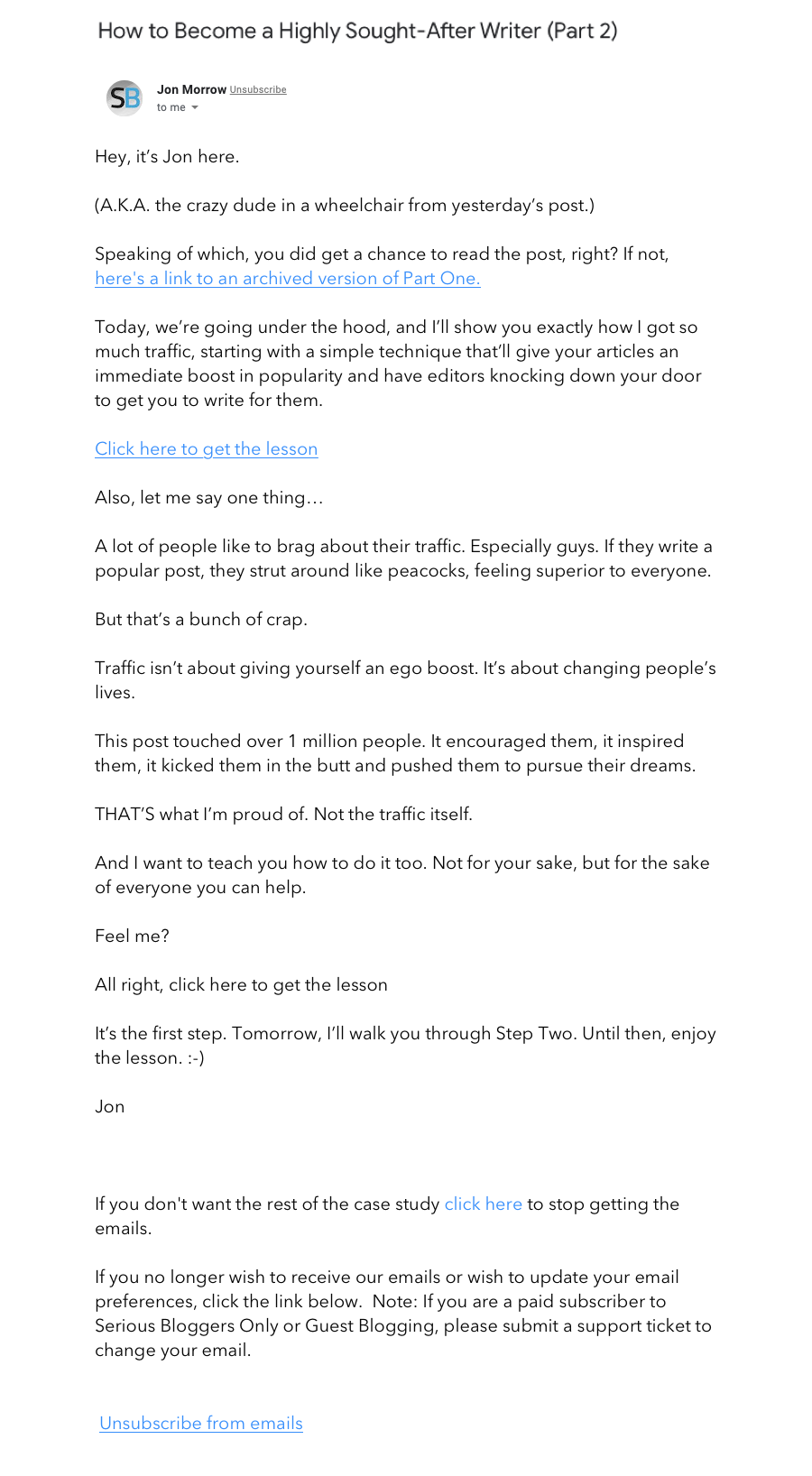
Again, this email delivers the thing that was promised yesterday — in this case: “a simple technique that’ll give your articles an immediate boost in popularity and have editors knocking down your door to get you to write for them” — and then it skillfully creates suspense for the upcoming email.
Pretty simple, yeah?
But also crazy effective.
Jon sticks with the same format in his next email…

And the next…

You’ll also notice that each of Jon’s emails include links to the previous emails he’s sent as a part of his welcome sequence.
That’s important. If someone opens your third email, for instance, but hasn’t opened the first two, you want them to be able to quickly catch up.
The Thought Leader Welcome Sequence (Email 6, 7, & 8)
Now, in Jon’s 6th email, he finally offers his first product to new subscribers.
Here it is.

This email is also pretty simple. He introduces the problem that his new subscribers are still facing — “what if you’re just a beginner without a huge track record like me?” — and then offers his certification program with a temporary discount (which creates urgency).
From here, there are two more emails within Jon’s welcome sequence.
Here’s the next one, which riffs on the offer from the previous email…
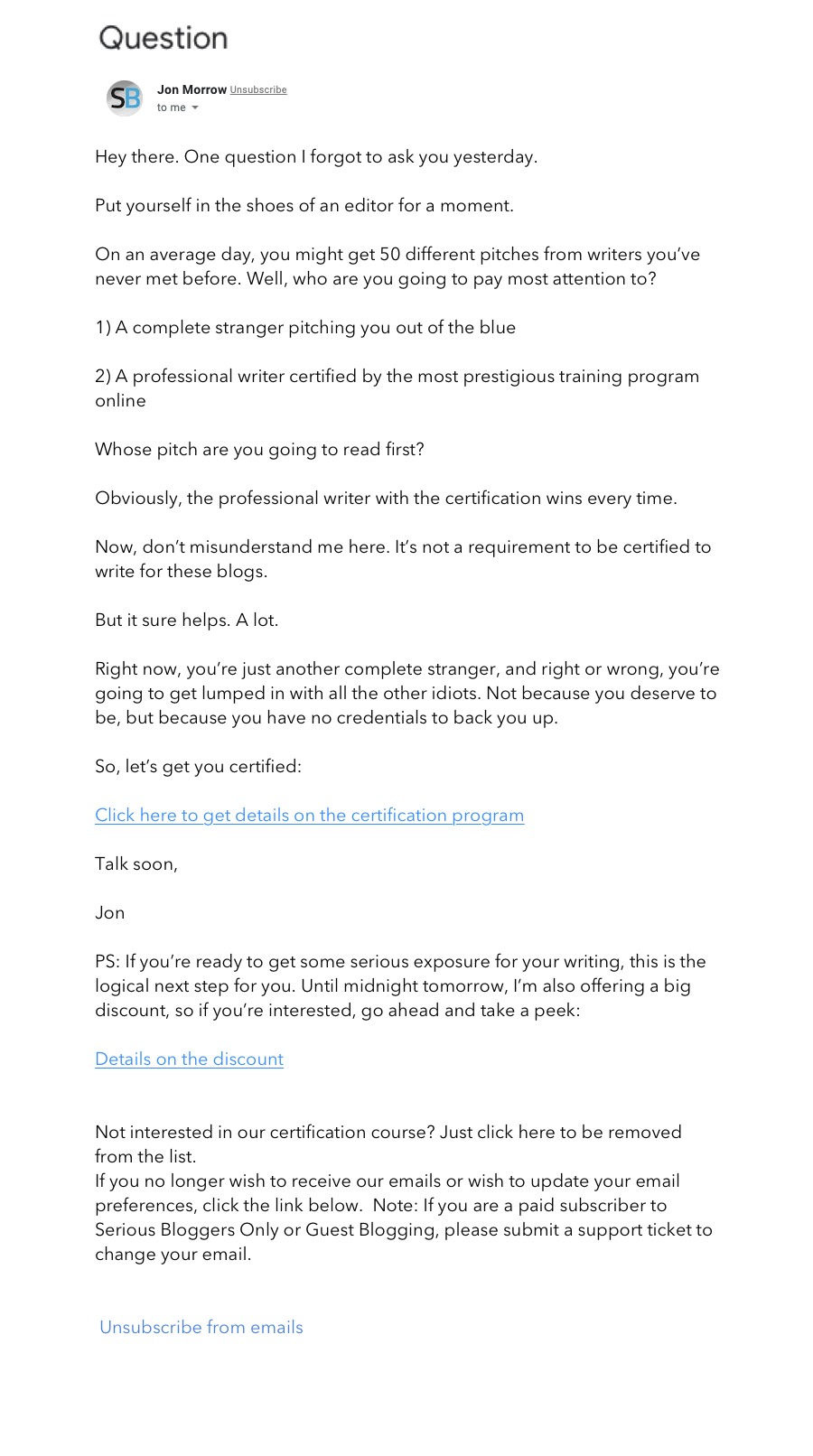
And here’s the final email, which focuses on creating a final sense of urgency…
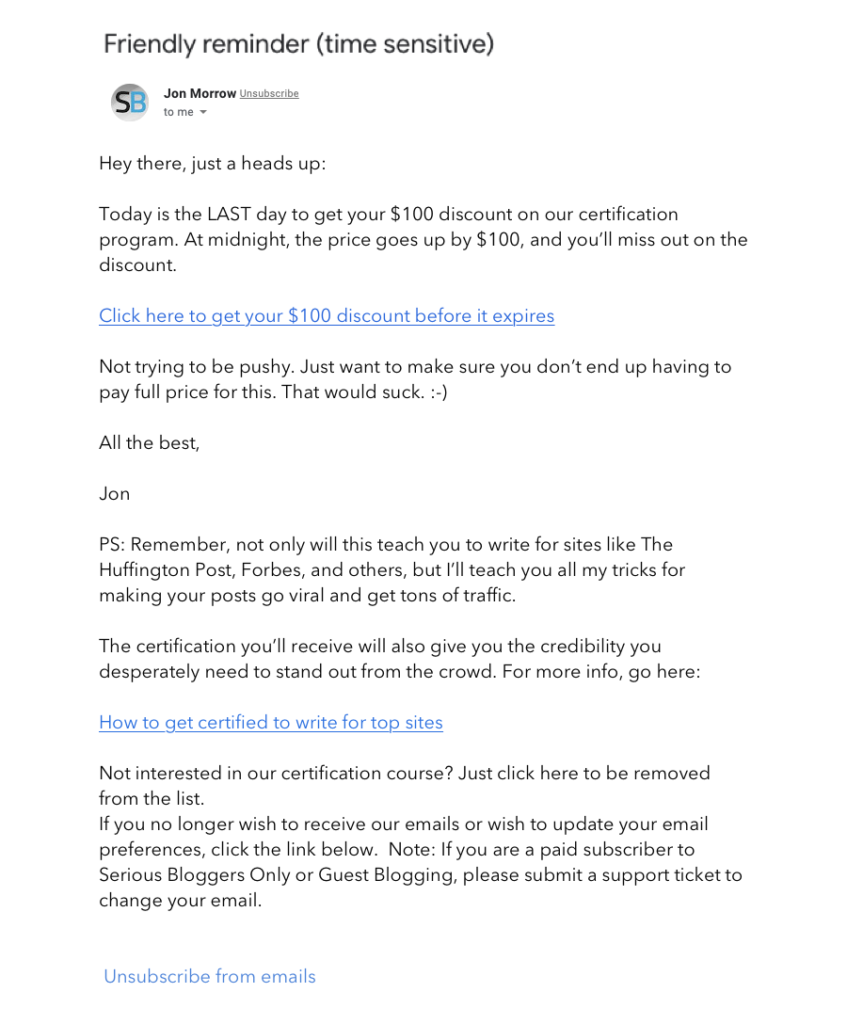
Although these last emails are just reminding people of your offer, they are really important.
Why?
Because most buyers are also procrastinators… just consider that the second busiest shopping day of the year in 2016 was December 23rd, the day before Christmas Eve.
Your welcome sequence isn’t an exception to this rule.
In fact, a buddy of ours, Jacob McMillen, gave us an insider look at a few of his recent email-based promotions (he sells online courses to freelance writers).
One of his sales sequences includes 4 emails leading up to his final-day CTA where he tells his subscribers that the deal is about to go away.
And you know what happens?
The vast majority of people buy on the last day of his promotion. Here’s what his dashboard looks like — he sent the final email on the 18th.
And in case you’re still skeptical, here’s what that curve looked like when he ran the same promotion one month later — can you guess when he sent the final email?
The point?
The majority of buyers are going to purchase your offer on the final day that you’re offering it. So don’t be shy about sending a few reminder emails like Jon Morrow and Jacob McMillen do.
The Thought Leader Daily or Weekly Emails
Once someone completes your welcome sequence, what are you going to send them?
Obviously, you need to stay in contact with these new subscribers, but how do you do it in a way that keeps the relationship feeling fresh and interesting?
That is, after all, the goal.
If people learn to trust that the content you provide is valuable to them, then they’re going to open more consistently.
So the first lesson is to keep that in mind whenever you’re crafting an email… think, is this email going to strengthen the relationship you have with your subscribers? Is it going to provide real value or insight for them? Is it going to increase their trust of your future content?
As far as how often you should email, that’s really up to you.
Many thought leaders swear that daily emails are the way to go, but weekly emails can also be very effective.
Do what’s realistic for you.
And remember: it’s better to start small and slowly increase than it is to start big and scale back because you overestimated your bandwidth.
You might just start with bi-weekly emails, see how it goes, and then increase to weekly or even daily once it makes sense.
Okay — that’s that. But what about the actual content of your weekly or daily emails? What are you going to talk about?
Let’s take a look at some examples of emails that thought leaders are sending.
First, here’s an email from Rachel Pedersen, the “Queen of Social Media.”
This email is easy to consume, provides real value, and has a “P.S”-CTA at the bottom. That CTA, by the way, has very little to do with the content of the actual email… which is totally okay in this context.
Overall, though, notice the casual feel of this email.
This is a style that you’ll see across most thought leader emails. It’s laid back, informative, and it feels like a real person is emailing you (as opposed to a big business or corporation).
Here’s another example from Ryan Robinson, who’s a blogging monetization expert…
Every month, Ryan creates an income report for his blog and then sends it to his subscribers.
Not only is that content extremely appealing to his readers, but it gives him an excuse to email them at least once a month.
Is there a monthly or weekly email you could send your subscribers that would give you an excuse to stay in touch?
This probably shouldn’t be the only type of email you send to your audience, but it can certainly fill part of the gap!
Here’s another email example from Scott Oldford, who’s a business coach and online entrepreneur…

The most noteworthy thing about this email is that it’s extremely honest and it doesn’t include a CTA (although it does indirectly remind people of his upcoming book).
Keep in mind that not all of your emails need to include a CTA. Some emails might only exist to strengthen your relationship with your subscribers, which is something that the above email does very well.
It’s also important to remember that, particularly as a thought leader in your niche, being honest about the challenges you’re facing doesn’t diminish your expertise, but makes you feel more human… and thus more trustworthy.
So don’t be afraid to talk about how you cried a little while working on your new book 😉
We could share a lot more examples of thought leader emails, but instead, let’s take a minute to talk about the types of emails you can send to your list…
Valuable Content Without CTA — It’s okay to sometimes send your list valuable information without trying to sell them something. You might just tell them a story or give them free advice. This is a great way to strengthen your relationship with your subscribers.

Valuable Content With Low-Key CTA — One of the most common types of emails you should send to your list is one that provides real value right inside of the email and then has a non-invasive CTA somewhere at the bottom (maybe even as a “P.S.” section). In this case, the content of your email doesn’t need to directly guide people toward your CTA… they can even be about slightly different topics.
Monthly Or Weekly Updates — What’s a valuable weekly or monthly update that you can send your audience? Maybe it’s an update on how you made money, what you learned, or even who you worked with. This update should be valuable to your audience and they should look forward to periodically receiving this content.

External Content Updates — Write a blog post, create a video, or publish a podcast recently? Sending external content to your email list is a great way to stay in touch and provide value.
Sales Sequences — Beyond your welcome sequence, you’re still going to periodically run promotions and create sales sequences. This is a natural part of running a thought leader business. Just make sure you balance out all of those heavy sales emails with free content and advice.
Here’s an example of sales email from Russell Brunson.
Conclusion
Hopefully, you now know what it takes to write great email copy for eCommerce, SaaS, and thought leader businesses.
Of course, the only way to actually get better at email copywriting is to do it.
So keep sending emails, keep testing, keep learning from your audience, and get a little bit better with every email.
Eventually, you’ll become a master.
